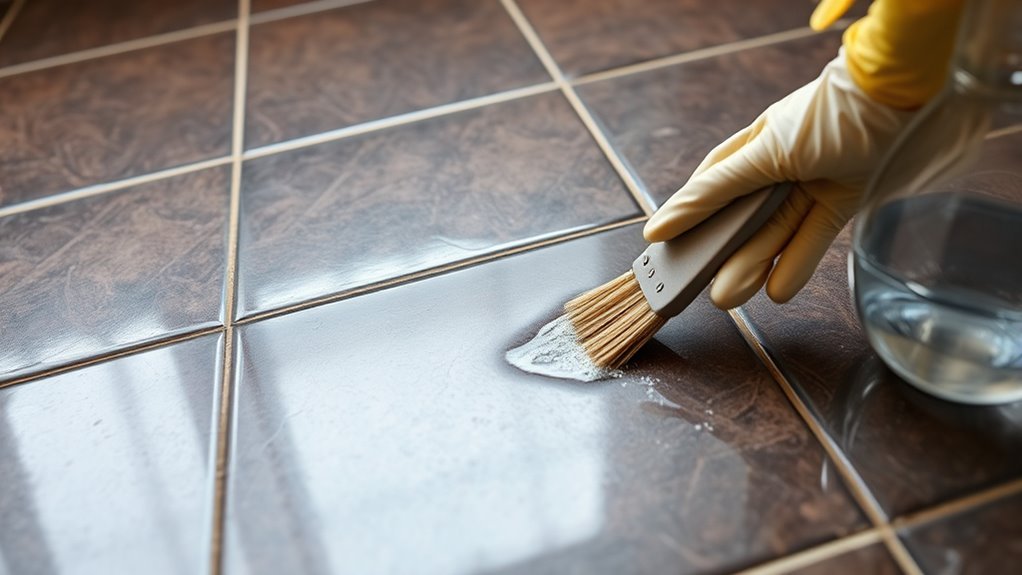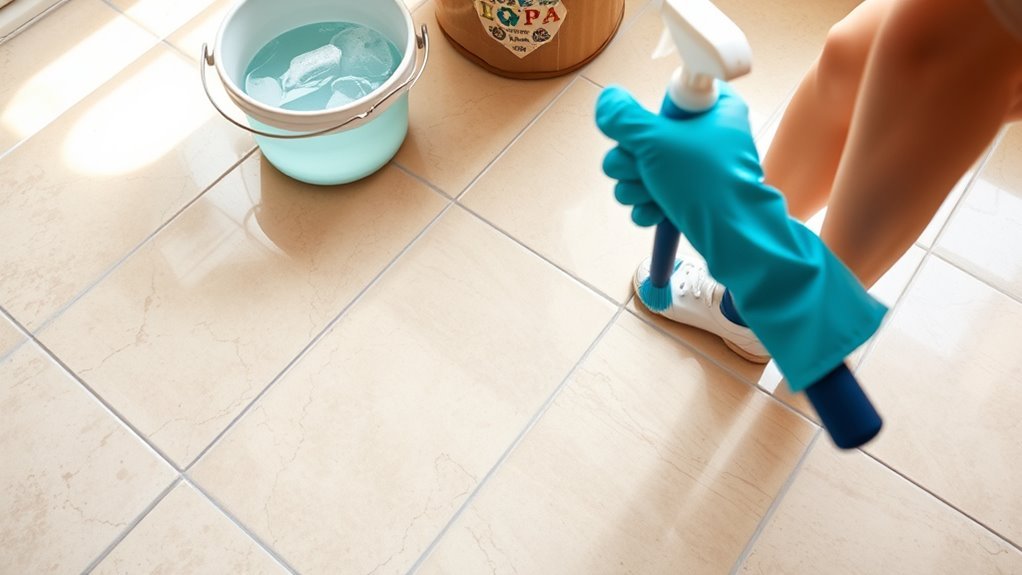Cleaning and Maintaining Tile and Grout
To clean and maintain your tile and grout, start by knowing your tile type since ceramic needs different care than natural stone. Use pH-neutral cleaners and a stiff grout brush for best results. Sweep first, then apply a mild detergent solution, scrub grout gently, rinse, and dry. For stains or mold, try baking soda paste or diluted vinegar, avoiding harsh chemicals on delicate tiles. Regular wiping, ventilation, and sealing help prevent buildup. Keep up these steps, and you’ll discover even smarter ways to protect your floors.
Understanding Different Types of Tile and Grout

When you’re cleaning tile and grout, knowing the types you’re dealing with makes a big difference. You’ll find ceramic tiles are popular—they’re durable, easy to clean, and resistant to stains, making your job simpler. On the other hand, natural stone like marble or slate demands more care. These materials are porous and prone to damage from harsh chemicals, so you’ll want gentle, pH-neutral cleaners. Grout varies too; some is sealed, some isn’t, affecting how you approach cleaning. Understanding these differences gives you the freedom to choose the right methods, protecting your surfaces while saving time. Being informed means you’re not at the mercy of trial and error—you control the process, keeping your tiles looking fresh without unnecessary hassle or damage.
Tools and Supplies Needed for Effective Cleaning
Knowing the type of tile and grout you have helps you pick the right tools and supplies to clean them effectively. You’ll want to gather essentials like pH-neutral cleaners for delicate tiles or stronger solutions for ceramic and porcelain. A good set of grout brushes is key; their stiff bristles reach deep into grout lines, making stubborn dirt easier to remove. Microfiber cloths and mops help you wipe away residue without scratching surfaces. Don’t forget a spray bottle to apply your cleaning solution evenly. Having the right tools aligns with smart cleaning techniques, letting you maintain your freedom from constant scrubbing and harsh chemicals. With these supplies ready, you’re set to keep your tile and grout looking fresh and lasting longer.
Step-by-Step Guide to Cleaning Tile and Grout

Cleaning tile and grout effectively involves a few simple steps that you can follow to restore their original shine. First, sweep or vacuum the area to remove loose debris. Then, mix a cleaning solution using warm water and a mild detergent or a specialized tile cleaner—the best cleaning techniques often involve gentle scrubbing with a soft brush to avoid damaging grout. Apply the solution generously, focusing on grout lines. After scrubbing, rinse thoroughly with clean water to remove residue. For grout color restoration, consider using a grout sealer or colorant to refresh faded lines and protect against future stains. Finally, allow everything to dry completely before using the space again. By sticking to these steps, you maintain freedom from tough grime and keep your tiles looking fresh and vibrant.
Removing Stains and Mold From Grout Lines
Even after regular cleaning, grout lines can develop stubborn stains and mold that won’t come off with basic scrubbing. To tackle these issues, focus on effective stain removal and mold prevention techniques that give you control over your space. Here’s a simple approach:
- Mix baking soda and water into a paste, apply it to grout lines, and let it sit for 10 minutes.
- Scrub gently with a stiff brush to lift stains without damaging grout.
- Use a diluted vinegar spray for mold, but avoid it on natural stone tiles.
- Rinse thoroughly with warm water and dry the area completely to deter mold growth.
Preventive Measures to Keep Tile and Grout Clean

While grout stains and mold can be stubborn, you can greatly reduce their occurrence by adopting simple preventive measures. Using preventive techniques like wiping spills immediately and ensuring good ventilation helps keep your tile and grout looking fresh. Regular inspections allow you to spot issues early before they become tough stains or mold.
| Preventive Technique | Frequency | Benefit |
|---|---|---|
| Wipe spills immediately | Daily | Prevents stains |
| Ventilate rooms | Daily | Reduces mold growth |
| Sweep or vacuum | Weekly | Removes dirt and debris |
| Regular inspections | Monthly | Detects early problems |
Tips for Long-Term Maintenance and Sealing
Since tile and grout are exposed to constant wear, maintaining their appearance and durability requires regular care and sealing. To enjoy freedom from frequent deep cleanings, follow a smart maintenance schedule and use effective sealing techniques. Here’s how you can keep your tiles looking fresh and protected:
- Clean grout regularly with a pH-neutral cleaner to prevent buildup.
- Apply a high-quality sealer every 1-2 years, or as recommended.
- Inspect grout lines periodically for cracks or wear, addressing issues promptly.
- Avoid harsh chemicals that can degrade sealants and grout integrity.
Frequently Asked Questions
Can I Use Vinegar on All Types of Grout?
You might be tempted to use vinegar on all grout types because of vinegar effectiveness as a natural cleaner, but you should be cautious. Vinegar’s acidity can damage certain grout types, especially those made from natural stone, like marble or limestone. If you want to keep your freedom to choose cleaning methods without risking damage, always check your grout type first. For safer results, stick to pH-neutral cleaners on sensitive grout.
How Often Should Professional Tile Cleaning Be Scheduled?
Think of your tiles like a well-loved road that needs smooth upkeep to keep you rolling freely. For professional cleaning frequency, aim for every 12 to 18 months to preserve that fresh shine and durability. Pair this with regular tile maintenance tips, like quick spills cleanup and gentle daily care, so you’re not chained to constant scrubbing. This balance lets your floors stay vibrant, giving you the freedom to enjoy your space without worry.
Are There Eco-Friendly Cleaning Products for Tile and Grout?
Yes, you can absolutely find eco-friendly cleaning products that work great for tile and grout. You don’t have to rely on harsh chemicals—natural cleaners like vinegar, baking soda, and lemon juice make effective DIY solutions. These ingredients are safe, affordable, and let you take control of your cleaning routine without harming the environment. Plus, making your own cleaner gives you the freedom to customize scents and strength to fit your needs perfectly.
Can Pet Urine Permanently Damage Grout?
Think of your grout like a fortress wall protecting your floor. When pet urine seeps in, it can cause stubborn urine stains that might feel like an uninvited breach. If you don’t act quickly, the damage can become permanent. But here’s your freedom: by regularly applying grout sealing, you create a shield that repels moisture and stains. This way, your floors stay fresh, and you keep your home feeling open and unconfined.
Is Steam Cleaning Safe for All Tile Materials?
You’ll want to check tile material compatibility before using steam cleaning techniques, as not all tiles handle heat and moisture well. Porcelain and ceramic usually tolerate steam cleaning fine, but natural stones like marble or limestone can get damaged or stained. So, before you plunge in, make sure your tile type can handle steam to avoid any unwanted damage. This way, you’re free to clean confidently without worry.






